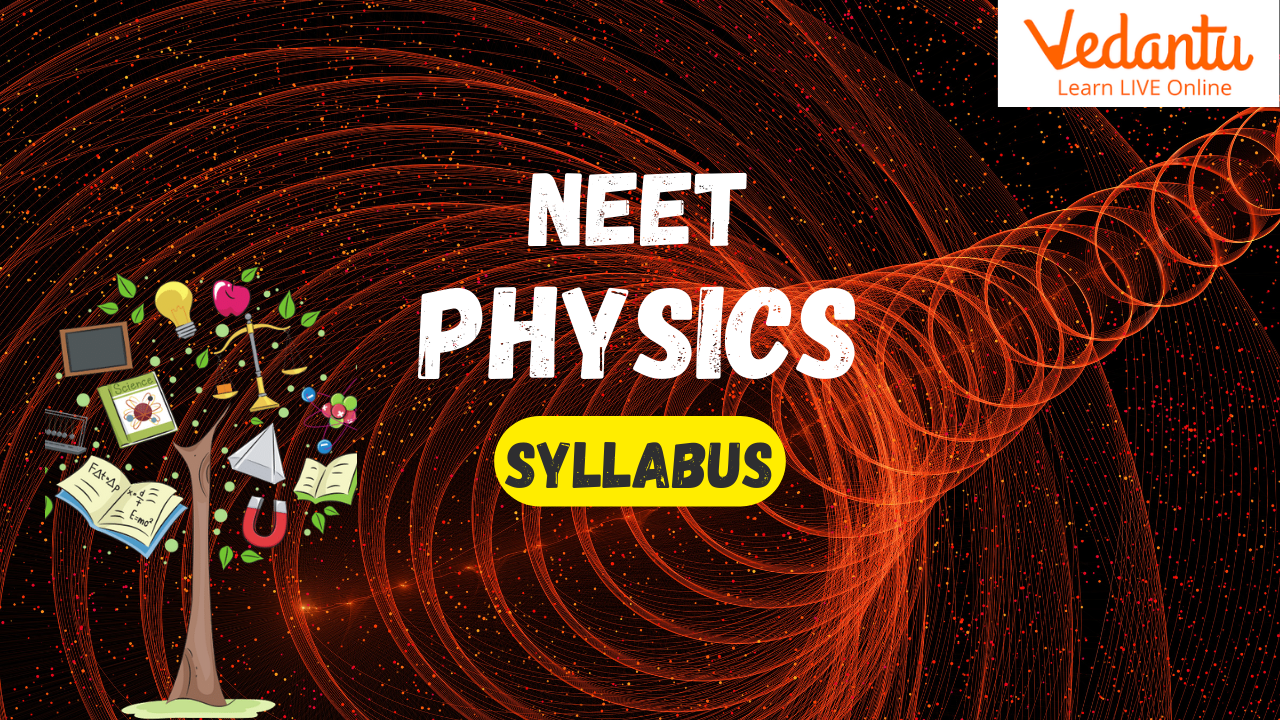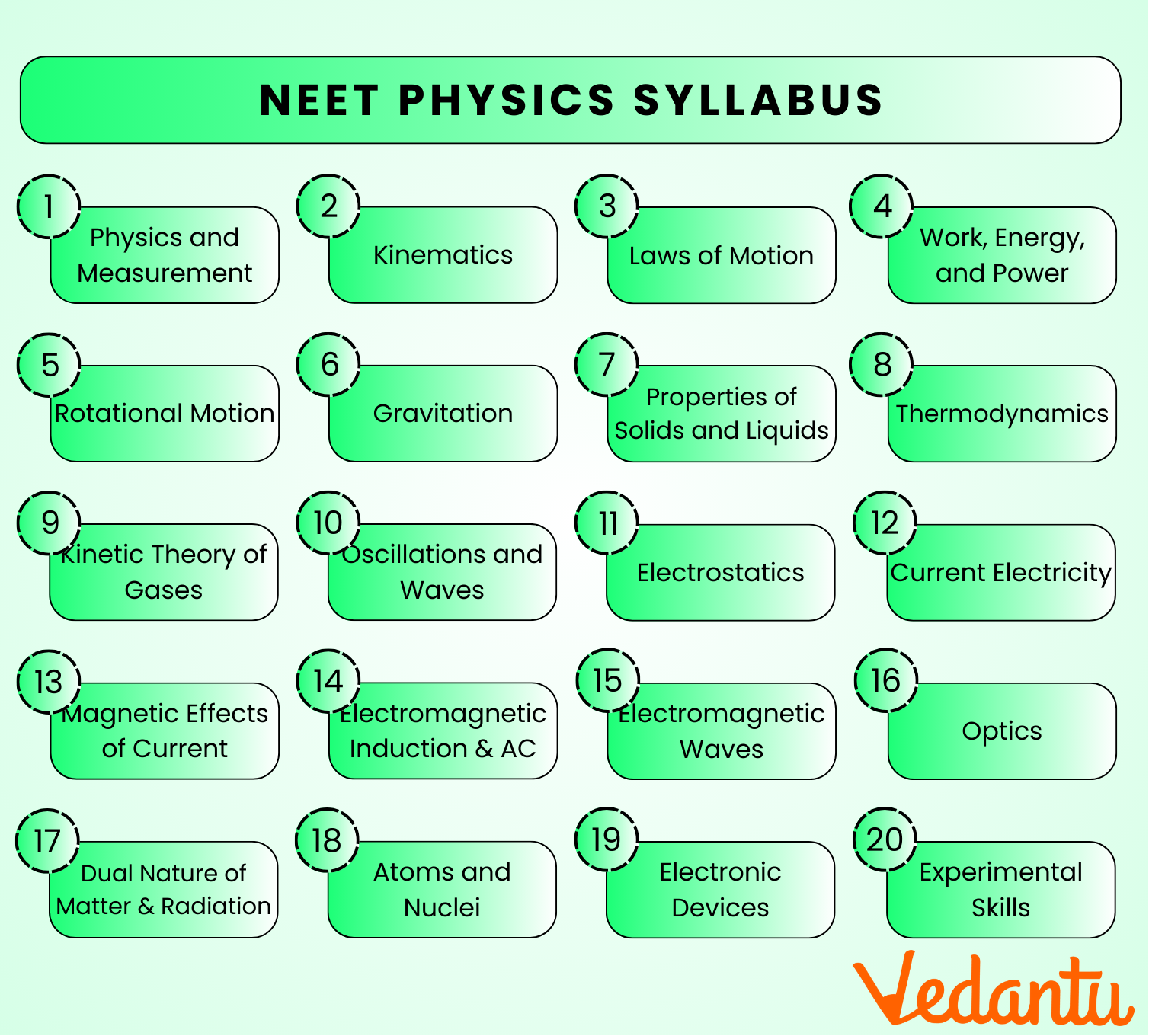Updated NEET UG Physics Syllabus 2025: Chapter-wise Weightage and Important Topics
FAQs on NEET Physics Syllabus 2025 - FREE PDF
1. What topics are included in the NEET 2025 Physics syllabus for Class 11?
The NEET 2025 Physics syllabus for Class 11 includes fundamental topics like Units and Measurements, Kinematics, Laws of Motion, Work, Energy, and Power, Gravitation, Properties of Solids and Liquids, Thermodynamics, Oscillations and Waves, among others. These are the foundational topics necessary for understanding advanced concepts in Class 12.
2. What are the important topics for NEET 2025 Physics Class 12?
Important topics in the Class 12 syllabus include Electrostatics, Current Electricity, Magnetism and Matter, Electromagnetic Induction, Optics, Dual Nature of Matter, Semiconductor Electronics, and Modern Physics. These topics carry significant weight in the NEET exam and require detailed understanding.
3. Are there any deleted topics in the NEET 2025 Physics syllabus?
Yes, several topics have been removed from the NEET 2025 Physics syllabus. These include advanced topics such as LC oscillations (qualitative treatment), Davisson-Germer experiment (experimental details omitted), and some topics in Mechanics and Electromagnetic Induction.
4. How do I prepare for NEET Physics effectively?
To prepare for NEET Physics:
Understand the concepts: Build a strong foundation in both Class 11 and Class 12 topics.
Practice problems: Solve a variety of problems to strengthen your problem-solving skills.
Revise regularly: Focus on key formulas and theorems.
Use reference books: Books like HC Verma and D C Pandey are highly recommended for NEET preparation.
5. What are the most challenging chapters in NEET Physics?
Some of the most challenging chapters in NEET Physics include:
Electrostatics and Capacitance: Requires understanding of electric fields and potential.
Magnetic Effects of Current: Biot-Savart law and applications can be difficult.
Modern Physics: Quantum mechanics and atomic models may require extra effort.
Thermodynamics: The laws of thermodynamics, the Carnot cycle, and related calculations can be tricky.
6. Will NEET 2025 have questions from both Class 11 and Class 12 Physics?
Yes, the NEET exam will have questions from both Class 11 and Class 12 Physics topics. The questions are designed to test your overall understanding of the subject, with an equal distribution from both classes
7. What are the best resources for NEET Physics preparation?
Some of the best resources for NEET Physics preparation include:
NCERT Physics textbooks
HC Verma’s Concepts of Physics (for building concepts and practice)
D C Pandey (for problem-solving)
Previous years' NEET question papers and mock tests
8. How should I prioritise topics for NEET Physics 2025 preparation?
It’s advisable to prioritise topics based on their weightage and your comfort level. Some high-weightage topics include:
Electrostatics, Current Electricity, Optics, Modern Physics.
Ensure to cover the basic chapters first and then focus on the advanced ones.
9. Is it necessary to study the entire syllabus for NEET 2025 Physics?
Yes, while some topics have been removed, studying the entire syllabus is essential to ensure you don’t miss any important areas. Focus on conceptual clarity, problem-solving techniques, and time management during practice.
10. How many chapters are included in the NEET 2025 Physics syllabus?
The NEET 2025 Physics syllabus includes 19 chapters in total. This is divided between Class 11 and Class 12 topics, with the majority covered in Class 12.
11. Can I skip any topics in NEET Physics preparation?
It is not advisable to skip any topic, as every topic can contribute to your overall score. However, you can prioritise high-weightage and relatively easier topics based on your strengths and weaknesses.
12. How should I tackle numerical problems in NEET Physics?
For numerical problems, focus on:
Understanding the formulae: Memorise key formulas and their applications.
Step-by-step approach: Solve problems methodically, identifying given data and then applying the formulae.
Practice: The more problems you solve, the more your speed and accuracy will improve during the exam.












